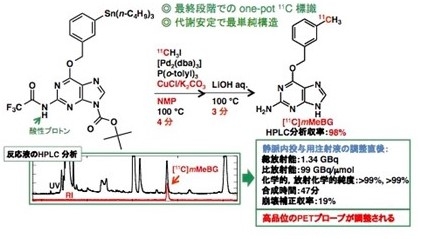EnglishPage
KOYAMA Hiroko
|
 |
| Title |
Associate Professor
|
|---|
| Department |
Department of Chemistry and Biomolecular Science |
|---|
| Course |
Biomolecular Science Course |
|---|
Research fields
Positron emission tomography (PET) is a noninvasive molecular imaging technique for monitoring drug (or drug candidate) behavior and its localization in the living system. Especially, it is a superior method to develop study of brain. We have proceeded "the development of rapid C-methylations useful for PET tracers synthesis labeled by short-lived positron-emitting radionuclides 11C with a half-life of 20.4 min" under the leadership of Prof. Suzuki. As main results, we have established rapid C-[11C]methylaiton into a hetero-aromatic ring which appear in major drugs and the rapid cross-coupling reaction between two sp3-hybridized carbons. These reactions proceed in only five minutes. We have completed to realize our-objected four types of rapid C-[11C]methylations generally applicable to the 11C-labeling of almost any organic frameworks. Recently, based on these methods, we successfully synthesized a high functional PET probes toward the drug development and diagnosis of brain functional disorder (such as Alzheimer's disease) and brain tumor (such as drug resistance cancer) (Fig. 1). We are now studying PET molecular imaging in collaboration with biomedical scientists. Thus, the establishment of an interdisciplinary research field for animal and human aiming from basic to actual use in which chemistry, biology, and medicine are closely collaborated is getting increasing important in promoting "in vivo Molecular Science".
 |
|
|
| Fig 1. Example for the development of in vivo molecular imaging technology: Synthesis of PET probe for imaging DNA repair protein MGMT(Bioorg. Med. Chem. Lett. 2017). |
|
Research Overview
Research Keywords
|
11C and 18F labeling method
|
|
high-functional PET probe
|
|
in vivo molecular imaging
|
|
|
|
Details page






















